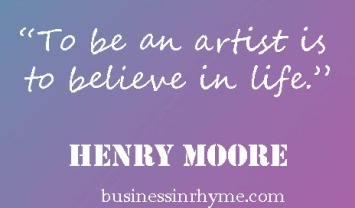The truth is: you can be very good at arts or writing – creative, interesting, refreshing, innovative, but if you lack certain business skills, hardly will your art ever get real market attention it deserves. There is a snobbery feeling that surrounds the idea of commercializing arts, hence – if you want to make a living from something that you are passionate about; something that comes from creative action – you have to start from somewhere.
When you think more clearly there are certain traits that accompany both artists and entrepreneurs. Like entrepreneurs, artists usually have a vision and a necessary drive to make that vision reality. On the other hand, having your own business requires certain degree of creativity: how to make your business unique or how to attract and impress customers?
But there are three important areas that I would like to emphasize, which every creative should explore and develop in order to become a successful business owner.
1.Know your limitations
Are you a good strategist? Are you firm in your decisions? How much are you prepared of your valuable time to spend on administrating tedious bureaucratic work and how eager are you to invest in the promotion of your work? Do you like to network or you rather spend hours and hours in your secluded creative space, contemplating your next piece and not having interest in anything else? Because, how at the beginning of your entrepreneurship you answer these questions can determine the course of your business. Many talented artists that succeeded, didn’t succeed by chance – they implemented strategically developed plan and had very clear idea what they needed to do. As an aspiring creative at the beginning you are mostly on your own – how much you invest, determines how much it will pay off later.
2.Be curious and do your research
To turn their work into sellable products, creatives first must know market demands. Do you know your audience? You have to be clear if there is an interest in what you have to offer. Then, do you know the monetary value of your work? Many artists struggle with estimating price range of their products because overvaluing is as much bad as underpricing your work.
3.Build your web of collaborators.
Now, the third aspect allows you to work on the first two simultaneously. You are not the only creative/entrepreneur starting his own business. Mingle, meet & greet similar people who have skills or services that you might lack! You can exchange services and help each other move forward with building the business. You will certainly broaden your network and is also an opportunity for you to promote your products/services.
The key is to find a balance and be persistent. There will be good days, but also bad days. Ideally, as proposed by The Design Trust creative entrepreneurs should spend around 40% of their time creating, 40% on marketing, 10% on administration and 10% on professional development. Some of these things can be quite overwhelming, but being determined in setting your goals and working on them will help you derive your priorities, day by day, project by project.



This is an informative post. Thank you for sharing.
LikeLike
You are welcome Amitav 🙂
LikeLiked by 1 person
Pretty informative and motivational piece. A good read. Keep sharing your tips of wisdom. Thanks a lot!
LikeLike
You are welcome and thank you for your continual support 🙂
LikeLike
Food for thought. It is so easy to become self absorbed in the process of creating and forgetting the point of it all: getting it out there.
LikeLike
I tottaly agree 🙂
LikeLike
Great read! Quite Inspiring
LikeLiked by 1 person
I’m glad you like it!
LikeLike